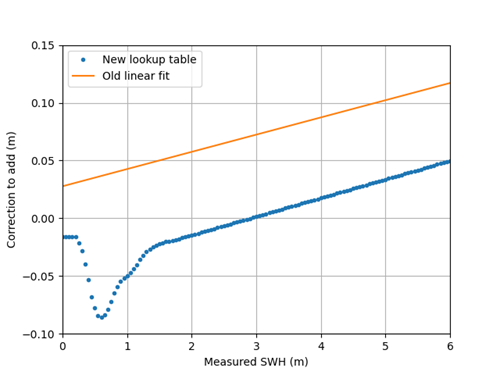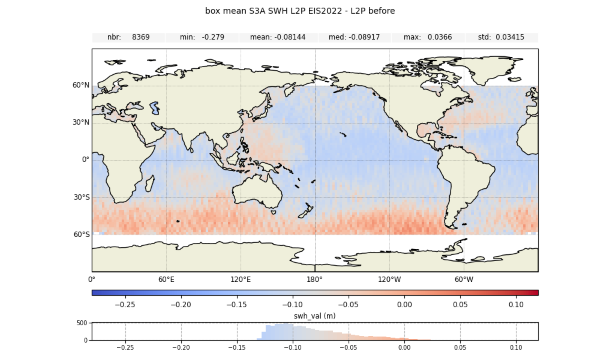Level-2Plus Wave products: New calibration of Jason-3 against in-situ data
RELEASE :
the 29 November 2022
System v3.0
The waves of the reference mission are calibrated against in-situ data over 4 years of data. The Level-2Plus waves of the other missions are calibrated on this reference mission corrected by buoys.
Currently the L2P wave products (up to version 2) were intercalibrated on Jason-3 and then a linear fit, determined by Queffeulou and Croizé-Fillon (2017) between Jason-2 and in-situ data, was applied to calibrate all the missions on the in-situ data. Nevertheless, comparison of L3 wave products (which use L2P wave products as input) with buoys have shown that the L2P/L3 wave products overestimate the swh. For L2P wave products version 3 a new absolute calibration between the reference mission and in-situ data will be used. In 2022, Jason-3 was calibrated against in-situ data, and a new lookup table has been produced by Dodet and Piollé (2021). This new absolute calibration replaces the old linear fit determined by Queffeulou and Croizé-Fillon (2017). There are two advantages to this new calibration:
- the first is that as there was not enough data for Jason-3, the former calibration had been done on Jason-2 mission and used for Jason-3. Now Jason-3’s record is sufficiently long to produce its own, independent calibration.
- the second is that a lookup table is sensitive to non-linearities in the correspondence between the in-situ and altimetric measurements, whereas the linear function by definition was not (figure 1 below).
Although Sentinel-6a is the new reference mission, until such a time as a sufficiently long record exists to permit a new calibration, it will be cross-calibrated with Jason-3 the same as any other secondary mission. However future missions that cannot be cross-calibrated with Jason-3 will be cross-calibrated with Sentinel-6a (which is itself cross-calibrated with Jason-3, which in turn has been calibrated against in-situ data).
The new absolute calibration leads to differences from the preceding one which depend on the mission. For example, Figure 2 shows the regional differences for Sentinel-3A. We can see an impact for low and high waves. A more exhaustive validation is done in section VI of the QUID (https://catalogue.marine.copernicus.eu/documents/QUID/CMEMS-WAV-QUID-014-001.pdf) to present and assess the quality of the new calibration.
CALIBRATION PERFORMANCES :
For validation purposes, the L3 wave products (which use the L2P wave products as input) are compared to buoys.
The new calibration produces a lower bias for every mission, and a lower RMSE. Sometimes the scatter index is higher with the new calibration, however it has been noted that this measure (and the RMSE) is not always reliable, because the mean and scatter are partially linearly dependent (Mentaschi et al., 2013). The HH index is a more reliable indicator for validation purposes (Mentaschi et al, 2013), so it is included here as well, and it unambiguously favours the new calibration over the old one.

DATA INFORMATIONS :
The switch to the new absolute calibration has been done on November 29. The new files are available in the same folder as the current operational one with no change in the format or nomenclature. Only the global attribute “product_version” will change from 2_0 to 3_0
L2P wave/wind handbook: https://www.aviso.altimetry.fr/fileadmin/documents/data/tools/hdbk_L2P_WAVE_S3_S6.pdf
References:
Dodet, G. and Piollé, J-F. (2021): Calibration of Level 2 Jason-3 GDR-F significant wave heights against in-situ measurements. Technical Report (Ifremer).
Queffeulou P. and Croizé-Fillon D. (2017): Global Altimeter SWH Data Set, version 11.4, February 2017. Technical report Ifremer. ftp://ftp.ifremer.fr/ifremer/cersat/products/swath/altimeters/waves/documentation/altimeter_wav e_merge__11.4.pdf
Mentaschi, L., Besio, G., Cassola, F., & Mazzino, A. (2013). Problems in RMSE-based wave model validations. Ocean Modelling, 72, 53-58.






